Face Muscles
We smile and grin depending on how we feel, pout and chew our food. This is all thanks to our face muscles doing all the work.

Face muscles (also called facial muscles or craniofacial muscles) are are group of around 20 muscles that lay just under the skin of the face and scalp. Most of them are attached to bones or structures around the skull. They have the particular quality of not having fascia around them like other skeletal muscles and they are very subtle.
Depending on the area that they are around, they can be part of certain groups of muscles that perform a movement together.
- Muscles of the mouth
- Muscles of the nose
- Muscles of the eyelid
- Other muscles

What do these face muscles do?
They are responsible for facial expression, chewing and keeping eyes and mouth closed or open. They’re innervated by the Facial nerve (CN VII) and supplied mostly by branches of the Facial Artery.
Muscles of the mouth (buccolabial group)
The buccolabial (mouth and lips) is comprised by
- Levator labii superioris alaeque nasi
- Depressor anguli oris
- Mentalis
- Orbicularis oris
- Levator anguli oris
- Risorius
- Zygomaticus major and minor
- Depressor labii inferioris
- Buccinator
They work as a compound to control the movements and shape of the mouth and lips. They can lower and evert the lower lips, close them, compress the cheeks and elevate and ever the upper lip.
Muscles of the nose (nasal group)
- Nasalis
- Procerus
These two muscles are involved in performing facial expression such as angry face and disgust and sneering. They are also used for breathing (flaring up the nostrils wide).
Muscles of the eyelid
- Orbicularis oculi
- Corrugator supercilii
Orbicularis oculi is a spincter-like muscle that keeps the eye in it’s place, protects it from foreign objects by closing the eyelids and do expressions such as anger, wincing, widen the eyes, and it compresses the lacrimal glands and ducts. Corrugator supercillii helps create the expression of frowning.
Other muscles
The occipitofrontalis muscle is a wide muscle that lies over the scalp, stretching from the eyebrows to the superior nuchal lines in the occipital bones in the back of the head. It has two bellies–frontal and occipital–and some authors may consider it to be two different muscles. They are both connected by the gale aponeurotica or epicranial aponeurosis which appears to interrupt them. The frontal part pulls the scalp forward and frowns and the occipital part retracts the scalp.
Interesting fact
Interestingly enough, a study back in 1967 described the development of face muscles in humans, it’s an interesting read from the American Association for Anatomy.
References
Standring, Susan. Gray’s Anatomy: The Anatomical Basis of Clinical Practice. , 2016. Print.
Sobotta Tables of Muscles, Joints and Nerves, English/Latin – 2nd Edition. Print

Leave a Reply